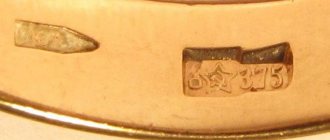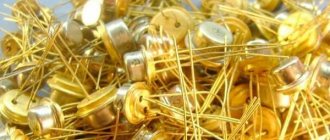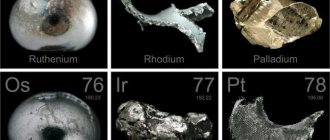Good afternoon, readers! In this article you will find information about one of the most complex processes in chemistry - the dissolution of gold. With the help of my tips, you can recreate the most severe reaction yourself and without special skills!
Gold is a fairly low-active metal. In nature, it is most often found as compounds. When an inexperienced chemist sets out to obtain pure precious metal, the question naturally arises in what gold dissolves. It is impossible to isolate it without dissolution. But finding a substance that will undergo a complex reaction is not an easy task; it’s not for nothing that gold is called a noble metal.
Industrial method
When extracting gold from so-called gold-bearing sands, you have to work with a suspension of approximately equally small particles of gold and grains of sand, which need to be separated from each other. You can do this by washing, or you can use sodium or potassium cyanide - there is no difference. The fact is that gold forms a soluble complex with cyanide ions, but sand does not dissolve and remains as is.
The key point in this reaction is the presence of oxygen (there is enough of it in the air): oxygen oxidizes gold in the presence of cyanide ions and a complex is obtained. If there is insufficient air or without cyanide, the reaction does not proceed.
Now this is the most common method of industrial gold production. Of course, there are still many stages before obtaining the final product, but we are specifically interested in this stage: cyanide solutions - what gold dissolves in.
Amalgam
The amalgamation process is also used in industry, only when working with ores and hard rocks. Its essence lies in the ability of mercury to form an amalgam - an intermetallic compound. Strictly speaking, mercury does not dissolve gold in this process: it remains in solid form in the amalgam.
During amalgamation, the rock is wetted with liquid mercury. However, the process of “pulling” gold into amalgam is long, dangerous (mercury vapor is poisonous) and ineffective, so this method is rarely used anywhere.
Equipment
To start refining both gold and silver in your home workshop, you will need to purchase quite a few tools and consumables.
Here is a list of the essentials:
- beakers per liter and 250 ml;
- laboratory funnel for transferring liquids;
- glass stick (at least 30 cm long);
- crucibles for melting;
- electric stove;
- thick rubber gloves;
- respirator with carbon filter;
- protective glasses;
- porcelain bowls for chemicals.
Aqua regia
There are many acids that can corrode living tissue and leave terrible chemical burns (even death). However, there is no single acid in which gold dissolves. Of all the acids, only the famous mixture - aqua regia - can affect it. These are nitric and hydrochloric (hydrochloric) acids, taken in a ratio of 3 to 1 by volume. The remarkable properties of this hellish cocktail are due to the fact that acids are taken in very high concentrations, which greatly increases their oxidizing ability.
Aqua regia begins to act when nitric acid begins to oxidize hydrochloric acid first, and during this reaction, atomic chlorine is formed - a very reactive particle. It is she who attacks gold and forms a complex with it - chlorauric acid.
This is a very useful reagent. Very often, gold is stored in the laboratory in the form of crystalline hydrate of such an acid. For us, it only serves as confirmation that gold dissolves in aqua regia.
It is worth paying attention once again to the fact that it is not one of the two acids that oxidizes the metal in this reaction, but the product of their mutual reaction. So if you take, for example, “nitrogen” alone - a well-known oxidizing acid - nothing will come of it. Neither concentration nor temperature can make gold dissolve in nitric acid.
Bleaching
Unlike acids, particularly hydrochloric acid, individual substances can become what gold dissolves in. A widely known household bleach is a solution of chlorine gas in water. Of course, you can’t do anything with an ordinary store-bought solution; higher concentrations are needed.
Chlorine water acts as follows: chlorine dissociates into hydrochloric and hypochlorous acids. Hypochlorous acid decomposes under light into oxygen and hydrochloric acid. In such decomposition, atomic oxygen is released: like atomic chlorine in the reaction with aqua regia, it is very active and oxidizes gold for the sweet soul. As a result, a complex of gold and chlorine is again obtained, as in the previous method.
Step-by-step instructions for dissolving gold
Dissolving metal is a labor-intensive process. An effective way is to use zinc. It is used by chemists to isolate the purest metal of high purity.
There are many videos that clearly show a violent reaction with zinc.
Required materials and tools
The following tools are required:
- heating container;
- large tweezers;
- plate;
- fireproof flask;
- cap with a slot;
- apparatus for melting metals.
Materials:
- pure sodium tetraborate (borax);
- concentrated nitric acid;
- hydrochloric acid of medium concentration;
- zinc.
Dissolution process
A heating container made of fireproof glass or porcelain with a small depression in the center must be freed from moisture and heated on the stove. Add sodium tetraborate to the recess of the container. Place the gold scrap in a container and heat it. After making sure that the crowbar has turned red, sprinkle it with tetraborate.
The gold begins to melt, which means you need to add small pieces of zinc to it.
The resulting solution must be boiled. After cooling, add clean, cool water to the flask to wash out the precipitate. Shake the flask to settle the yellow flakes, carefully drain the water and rinse until the water in the flask is no longer cloudy.
Separate the sediment from the water using gauze, squeeze out excess water and sprinkle with sodium tetraborate. Tie the gauze into a tight knot, place it in the flask and heat until the gauze smolders and the tetraborate melts. A golden lump should form at the bottom of the flask.
As soon as the metal ingot hardens, it must be pulled out, cleaned of any remaining borax compounds with oxidized metals, by boiling for five minutes in a solution of nitric and hydrochloric acids. You should end up with a smooth and shiny gold bar.
Other halogens
In addition to chlorine, other elements of the seventh group of the periodic table also oxidize gold well. It is difficult to fully say about them: “that in which gold dissolves.”
Gold can react with fluorine in different ways: during direct synthesis (at a temperature of 300-400°C), gold fluoride III is formed, which immediately hydrolyzes in water. It is so unstable that it decomposes even when exposed to hydrofluoric acid, although it should be comfortable among fluoride ions.
Also, by the action of the strongest oxidizing agents: fluorides of noble gases (krypton, xenon), gold fluoride V can be obtained. Such fluoride generally explodes upon contact with water.
With bromine, things are somewhat simpler. Bromine is a liquid under normal conditions, and gold dissipates well in its solutions, forming soluble gold bromide III.
Gold also reacts with iodine when heated (up to 400°C), forming gold iodide I (this degree of oxidation is explained by the lower activity of iodine compared to other halogens).
Thus, gold certainly reacts with halogens, but whether gold dissolves in them is controversial.
APPLICATION
Golden coins
In terms of its chemical resistance and mechanical strength, gold is inferior to most platinum group metals, but is irreplaceable as a material for electrical contacts. Therefore, in microelectronics, gold conductors and gold electroplating of contact surfaces, connectors, and printed circuit boards are used very widely. Gold is used as a target in nuclear research, as a coating for mirrors operating in the far infrared range, and as a special shell in a neutron bomb. A thin layer of gold (20 nm) on the inner surface of window and stained glass glass significantly reduces unwanted heat losses in winter, and in summer it protects the interior of buildings and vehicles from heating by infrared rays. Gold solders wet various metal surfaces very well and are used in metal soldering. Thin gaskets made from soft gold alloys are used in ultra-high vacuum technology. The traditional and largest consumer of gold is the jewelry industry. Jewelry is made not from pure gold, but from its alloys with other metals, which are significantly superior to gold in mechanical strength and durability. Currently, Au-Ag-Cu alloys are used for this, which may contain additives of zinc, nickel, cobalt, and palladium. The corrosion resistance of such alloys is determined mainly by their gold content, and the color shades and mechanical properties are determined by the ratio of silver and copper. Dentistry consumes significant amounts of gold: crowns and dentures are made from alloys of gold with silver, copper, nickel, platinum, and zinc. Such alloys combine corrosion resistance with high mechanical properties. Gold compounds are included in some medications used to treat a number of diseases (tuberculosis, rheumatoid arthritis, etc.). The radioactive isotope 198Au (half-life 2.967 days) is used in the treatment of malignant tumors in radiotherapy.
Gold - Au
| Molecular weight | 196.97 g/mol |
| origin of name | Proto-Slavic “*zolto” (“gold”) is related to Lit. geltonas "yellow", Latvian. zelts "gold". |
| IMA status | valid, first described before 1959 (before IMA) |
Lugol's solution
In fact, iodine (common iodine I2) is insoluble in water. Let’s dissolve its complex with potassium iodide. This compound is called Lugol's solution - and it can dissolve gold. By the way, it is often used to lubricate the throat of those with a sore throat, so not everything is so simple.
This reaction also occurs through the formation of complexes. Gold forms complex anions with iodine. It is used, as a rule, for etching gold - a process in which interaction occurs only with the surface of the metal. Lugol's solution is convenient in this case because, unlike aqua regia and cyanide, the reaction is noticeably slower (and the reagents are more accessible).
What is required for the process and how does the metal dissolve?
Before you begin the actual procedure, you should know how to dissolve gold. You also need to prepare in advance:
- Nitric acid.
- Sulfuric acid. Both components must be concentrated.
- Container for reactions. An ordinary beaker from a laboratory or a glass flask is best suited for this.
- And the main participant in the process is scrap jewelry, or any other part with elements of precious metal.
Many are surprised how it happens that a mixture of acids dissolves the king of metals. In fact, when two types of acids and a precious metal are combined, a new product appears.
It is called hydrogen tetrachloroaurate, or otherwise called chlorauric acid.
The reaction process itself occurs as follows - Au + HNO3 + 4 HCl = HAuCl4 + NO + 2 H2O.
This peculiar equation makes it objectively clear that for the dissolution process 1 g.
Precious metal will require at least 5 ml of reactive liquid. What is most interesting is that the solvent is not nitric acid, but sulfuric acid.
Bonus
When we said that single acids are something in which gold does not dissolve, we lied a little - in fact, such acids exist.
Perchloric acid is one of the strongest acids. Its oxidizing properties are extremely high. In a dilute solution they show up poorly, but in high concentrations they work wonders. The reaction produces its salt, gold perchlorate, which is yellow and unstable.
Of the acids in which gold dissolves, there is also hot concentrated selenic acid. As a result, a salt is also formed - gold selenate of red-yellow color.










